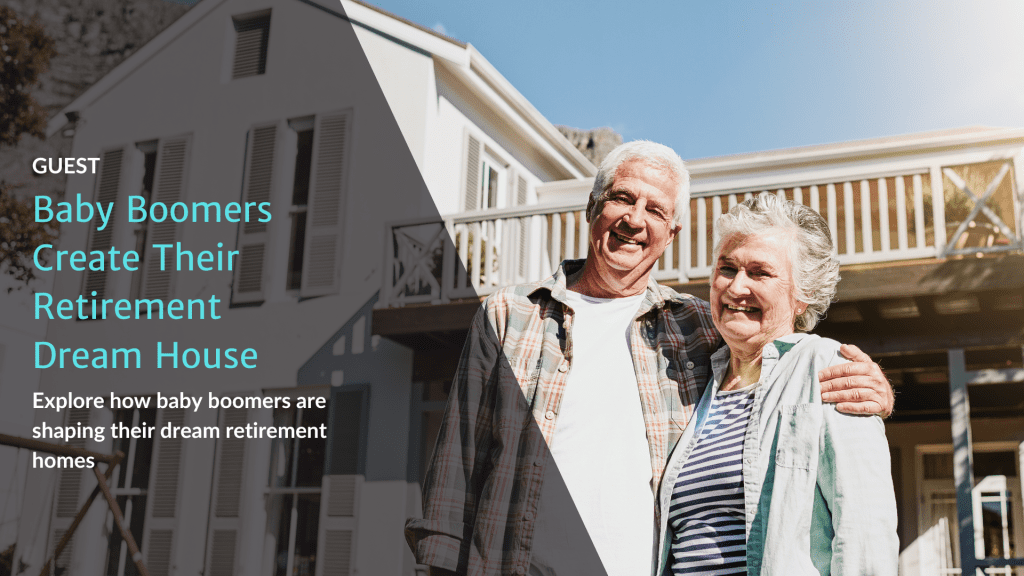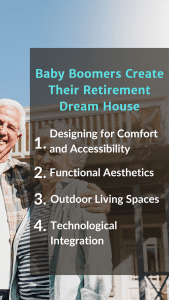
Baby Boomers Create Their Retirement Dream House
Retirement is a time to take it easy and reap the rewards of your hard work. For many baby boomers, this means living in a home that reflects their accomplishments and provides the peace and tranquility they crave. However, a retirement home should be more than just a place to live; it should be a sanctuary that combines luxury, comfort, and practicality. Thus providing an enriching and effortless living experience. So, if you're a boomer looking to create your dream retirement home, keep reading.
Planning Your Retirement House
Retirement home planning is about combining personal comforts and practical needs into a seamless living experience. It is a thoughtful process in which desires and necessities come together to create a vibrant picture of relaxed and gratifying living. Here are some tips on how to start planning your retirement home:
- Vision: Start with what you envision. Your retirement home should be a reflection of you, echoing your tastes, needs, and the leisurely pace you've earned.
- Space Utilization: Think about the layout and spaces that will foster relaxation and enjoyment. An open design, a cozy reading nook, or a spacious patio - every element should cater to your anticipated activities and moments of rest.
- Location: The setting of your home is key. Whether staying put and remodeling or moving to a new locale, consider the environment, accessibility, and proximity to loved ones or preferred surroundings.
- Professional Insight: A dream home is realized through collaboration. Lean into the expertise of professionals who can translate your ideas into architectural and design masterpieces.
Designing for Comfort and Accessibility
While aesthetic appeal is essential in designing a retirement home, it is also important to create a space that is both comfortable and accessible. This means incorporating intuitive design elements that make living easy and enjoyable.
- Ergonomic Design: Considerations for features like easy-to-reach cabinets, non-slip flooring, and spacious layouts reduce strain and enhance safety.
- Natural Light: Maximizing the influx of natural light to create warm, inviting spaces that are not just visually pleasing but uplifting.
- Easy Navigation: A layout that minimizes obstacles and allows for easy movement, catering to present and future mobility needs.
- Smart Technology: Integration of technology that simplifies life, from automated lighting to advanced security systems, ensuring peace of mind and ease of control.
Functional Aesthetics
In retirement living, beauty, and functionality are not two separate things but rather essential parts of a well-rounded home. It is a place where visual appeal is in balance with practical utility, making every day a dance of comfort and elegance. So, when planning your ideal retirement house, consider these factors:
- Custom Finishes: Elements that are not just about the visual appeal but also touch on the tactile experience, ensuring ease of use and maintenance.
- Flexible Spaces: Rooms and areas that adapt to various needs, ensuring the home evolves with changing requirements and preferences.
- Quality Materials: The use of materials that are enduring and elegant, ensuring the home remains a blend of sophistication and durability.
- Personal Touch: A design that's infused with unique elements, making the house a reflection of individual tastes and stories, a true home.
Consider a Home Remodel
If building or buying a new home isn't in the cards for your golden years, remodeling your current space emerges as a prime alternative. It's a pathway to revitalize your living environment without the upheaval of a move. In fact, a remodel can infuse your familiar surroundings with modern comforts, enhanced accessibility, and aesthetic upgrades.
Additionally, you have the opportunity to customize your space to reflect the leisure and convenience that retirement brings, making every corner of your home a blend of personal nostalgia and modern luxury. In essence, it is about transforming the old into a sanctuary where every day is a unique blend of cherished memories and new, elegant living.
Outdoor Living Spaces
When planning your retirement home, don't forget to consider the outdoor living space. After all, retirement is a time to enjoy quality moments in the comfort of your own backyard. But keep in mind that this isn't about having a grand outdoor space but rather creating functional, low-maintenance areas where you can relax and entertain.
With this, think of gardens that are easy to care for but still full of color and life. And patios that aren't just open spaces but thoughtfully arranged settings that are comfortable and inviting. In other words, create the perfect setting for quiet moments or social gatherings.
Technological Integration
As we enter our retirement years, the role of technology in our homes is no longer about complexity or the latest trends. Instead, it's about enhancing convenience, safety, and enjoyment. Here are some examples of technologies that can seamlessly blend into the retirement living experience:
- Smart Lighting: Adjustable lighting systems that can be controlled remotely or programmed to adapt to your routines, ensuring optimal lighting for every moment of the day.
- Security Systems: Modern, easy-to-use security solutions that offer real-time monitoring and alerts, ensuring your peace of mind whether you're at home or away.
- Thermostats: Intelligent climate control that learns your preferences and adjusts automatically to ensure optimal comfort while being energy efficient.
- Home Automation: Systems that allow the integration and easy control of various home functions, from lights and climate to security, all from a single interface.
- Voice Assistants: Devices that offer hands-free control and assistance, making it easy to access information, control home functions, and stay connected without lifting a finger.
The key is choosing technologies that align with your lifestyle, simplifying tasks, and enhancing comfort, making every aspect of home living a more enjoyable and effortless experience.
Financing the Dream
As the idea of creating a dream retirement home takes form, the practical aspect of financing comes into play. This is a critical step where desires and financial realities collide, paving the way for a home that is both desirable and attainable. Here are a few common ways for baby boomers to finance their dream homes:
- Savings: Utilizing savings requires a well-planned budget, ensuring every dollar is maximized for both immediate and future needs.
- Loans: Exploring loan options should consider favorable interest rates and manageable repayment plans aligning with financial comfort.
- Investments: Liquidating or leveraging investments should be done with an eye on market trends and long-term financial health.
Your Next Chapter Awaits
In the pursuit of creating your dream retirement home, making informed choices is paramount. Ready to embark on this journey? We're here to assist. Our experienced team and tailored solutions are dedicated to transforming your dream into a reality, reflecting your accomplishments, and providing the tranquility you deserve.
More than builders, we're collaborators who bring your vision to life with precision and care. Let us help you plan your perfect retirement home today. Your dream awaits, so call us now!
Mini-FAQs
Building a house in retirement can be a thoughtful choice for those seeking a custom living space. However, it requires careful financial planning, considering factors like budget, location, and future needs. Consulting with a financial advisor and evaluating your long-term goals is crucial before embarking on such a project.
When building your dream home, it's essential to prioritize functionality, accessibility, and future needs. Consider factors like location, design, energy efficiency, and aging-in-place features. Work closely with architects and contractors to ensure your vision aligns with practicality, making your dream home a comfortable and sustainable haven.
Buying a house for retirement can be a beneficial investment, providing stability and a sense of ownership. It allows you to downsize, reduce housing costs, and potentially build equity. However, carefully assess your financial situation, retirement income, and future housing needs to determine if purchasing a home aligns with your retirement goals.
The ideal home size for a retired couple depends on personal preferences and needs. Many retirees opt for downsizing to a smaller, more manageable space that suits their lifestyle. A two-bedroom home with additional space for hobbies or guests is often a comfortable choice, offering flexibility and ease of maintenance while accommodating changing circumstances.

